How do you recognize a jackdaw and a young jackdaw? How can you tell jackdaw and carrion crow apart? And what does the jackdaw nest look like? We answer these and other questions in our profile.

the jackdaw (Corvus monedula) is often overshadowed by its well-known relatives, the carrion crow. It is often not even perceived as an independent bird species. They are particularly intelligent and lively birds that have always been closely associated with humans. Jackdaws are cultural followers and settled in our immediate vicinity early on. Even today, they breed primarily indoors, taking advantage of orchards, cornfields, and other human structures. You can find out how to clearly identify a jackdaw, recognize its call and how you can give the crows a home in our large profile.
contents
- Jackdaw: fact sheet
-
This is how you recognize the Jackdaw
- How do jackdaws and carrion crows differ?
- How does the jackdaw song sound?
- How do you recognize a jackdaw juvenile?
- What do jackdaw eggs look like?
- Which habitat does the jackdaw prefer?
- Where does the jackdaw build its nest?
- When is jackdaw breeding season?
- Where does the jackdaw spend the winter?
-
Support the jackdaw in the garden: Here's how
- What do jackdaws eat?
- Which nest boxes are suitable for jackdaws?
- How can you additionally support the Jackdaw?
Jackdaw: fact sheet
| size | Approximately 33 - 34 cm |
| Weight | About 250g |
| breeding season | April June |
| lifespan | Up to 20 years |
| habitat | Open but structured landscapes, parks and large gardens |
| feed preference | Omnivores: insects, worms, carrion, grains and berries |
| threats | Lack of nesting opportunities |
This is how you recognize the Jackdaw
Like most corvids, jackdaws are distinguished by their black plumage. However, they are smaller than most of their relatives, about the size of a pigeon. They are also easy to recognize by their blue-grey neck and bright light blue eyes. Jackdaw males and females cannot be distinguished from one another purely visually.
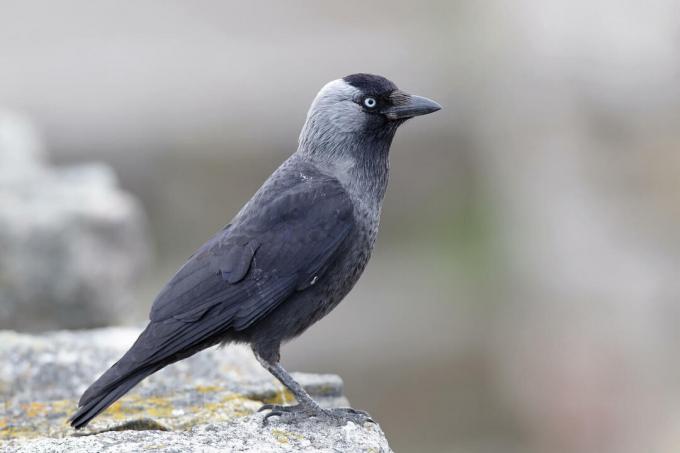
How do jackdaws and carrion crows differ?
Jackdaws are significantly smaller than their closely related counterparts carrion crows. They also appear less elegant, but rather stocky and compact. In addition, they have unique characteristics, such as the blue-grey neck and their light blue eyes, by which they can be recognized. Carrion crows, on the other hand, are monochromatic black.
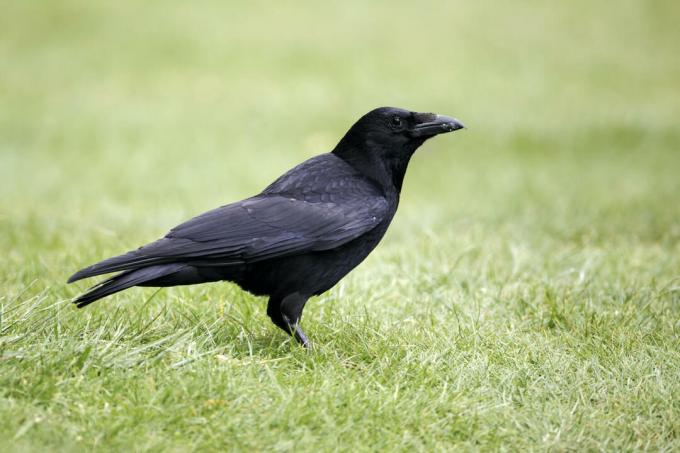
How does the jackdaw song sound?
Jackdaw song consists of a nondescript, harsh babble that has little structure. Other birds are often imitated or various sounds from the environment are recorded. The calls of the jackdaw, which can often be heard in groups or in flight, such as “kya-kya-kya”, are somewhat more identifiable. The warning calls sound like a hotter, drawn out "Tscharrrr".
The call of the jackdaw sounds like this:
How do you recognize a jackdaw juvenile?
Very young jackdaws that have just fledged are still quite inconspicuous. They are solid black and look quite similar to other crow chicks. However, the blue-grey nape plumage develops very quickly and the juveniles resemble the adult animals after just a few weeks - although the nape is even less intensely colored. In addition, young jackdaws can always be recognized by their bright, light blue eyes.
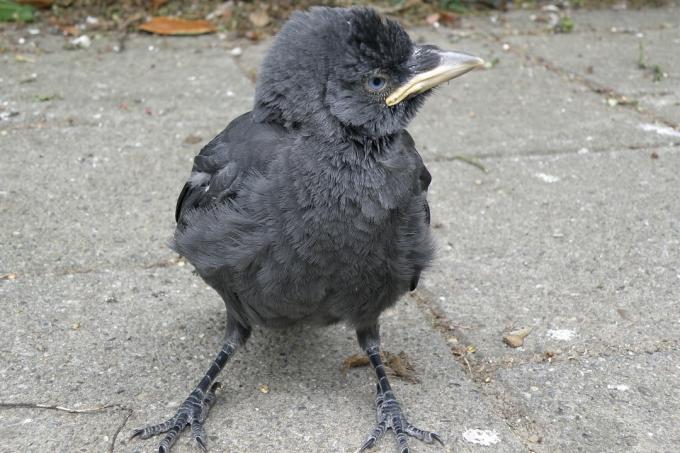
What do jackdaw eggs look like?
Jackdaws lay light blue eggs about 3 centimeters in size, which are covered with dark spots. Usually between four and six eggs are laid in a nest. The nest itself is in a cave and is made from small sticks, bits of bark, other plant fibers, hair, and soil.
Which habitat does the jackdaw prefer?
When looking for a suitable habitat, jackdaws look for two things: wide, open spaces where they can forage for food and cavernous structures in which to build their nests be able. They therefore like to live in fields and meadows near settlements, but also in quarries or cities with sufficiently large green spaces.
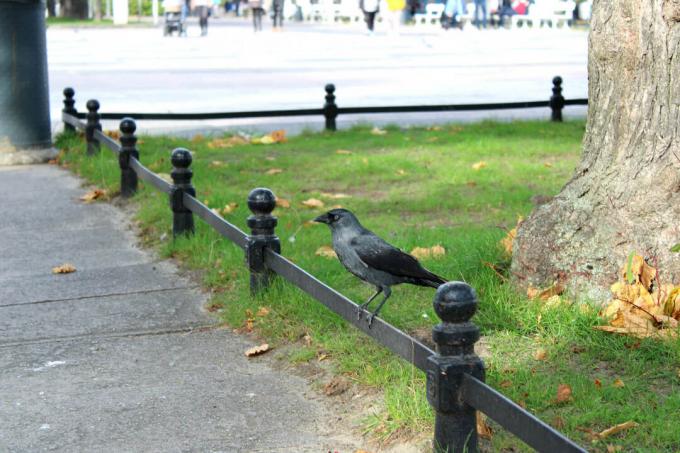
Where does the jackdaw build its nest?
Jackdaws are pronounced cave breeders. Naturally they would breed in crevices and niches in rocks, but these days they mainly use old buildings, making cracked facades and chimneys their own. But also natural tree cavities, such as knotholes or old woodpecker cavities, as well as nesting boxes are often used. Both sexes take care of the nest building itself and sometimes even unmated young birds from the previous year help.
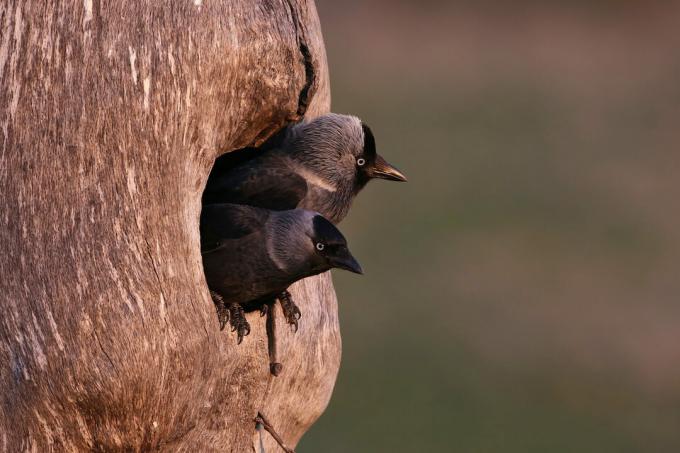
When is jackdaw breeding season?
Jackdaw breeding season begins in April. After laying the eggs, it is the female's job to incubate the eggs for up to 20 days. During this time it is supplied with food by the male. The newly hatched young birds are fed in the nest for four to five weeks and are supported by their parents in the search for food for the same length of time after they leave the nest. Jackdaw breeding season ends in June and no second brood follows. Jackdaws also breed monogamously, and most pairs stay together for life.
Where does the jackdaw spend the winter?
Most of our native jackdaws spend the whole year in Germany. Only a few populations leave their breeding grounds and migrate shorter distances to the south or south-west. In fact, we tend to have a surplus of jackdaws in winter, as animals from northern Europe often escape the freezing temperatures of their homeland and spend the winter with us.

Support the jackdaw in the garden: Here's how
Due to the renovation of old buildings, there are fewer and fewer nesting places for jackdaws. In some parts of Germany, the stocks are therefore already considered endangered. Here you can find out how you can offer the birds a home and support them in other ways.
What do jackdaws eat?
Jackdaws are real omnivores. They feed on insects, spiders, worms and other small animals, use carrion, fruit and berries. In winter you can often see them together with other crow relatives, such as carrion crows or rooks, foraging in fields.
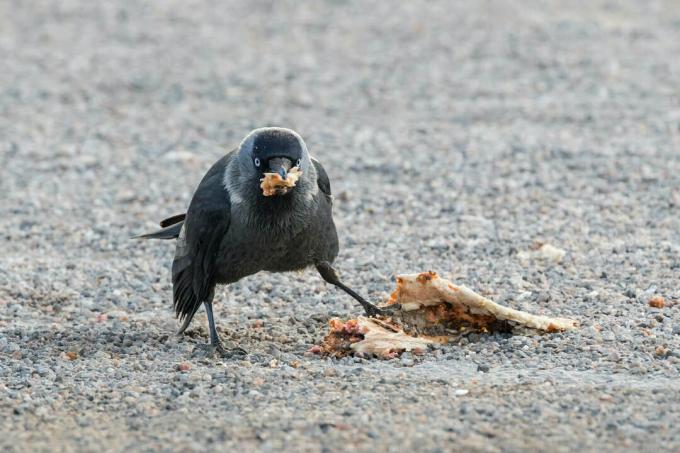
Jackdaws also like to visit bird feeders – whether in winter or during the breeding season. They are also not particularly picky about food and will take any form of bedding or grain food that is offered. Our Plantura year-round bird food for example, contains lots of rich seeds that crows can feast on - in winter it provides valuable seeds Energy for heat production and in summer it brings an extra load of proteins and an addition of feed lime for expectant ones bird parents.

Plantura year-round food for wild birds
High-protein year-round bird food
for all grain and soft feed eaters,
supports bird parents & their offspring
Which nest boxes are suitable for jackdaws?
If you want to offer jackdaws a nesting place, you can build a jackdaw nest box yourself with little effort. This should be a full cavity nesting box that is closed all around except for a small entry hole. The entrance hole should be 15 cm and the base of the nest box should be about 28 x 17 cm. The nesting aids should be placed at a height of several meters in a place that is safe from cats and other predators.
Tips on how to get one in general Build your own nest box can be found in our special article.

How can you additionally support the Jackdaw?
In addition to the offered birdseed, jackdaws are also happy about a rich natural food supply in home gardens. You too can by designing one insect friendly garden create a little jackdaw paradise. Do not use chemical pesticides, as these often contain toxic substances and not only counteract your insect-promoting measures, but also poison birds through the food chain be able.
You can also score points with garden birds by installing a watering hole. Whether pond, stream or water bowl - on hot days the feathered visitors will thank you. However, make sure you clean your water points regularly. Bird baths or baths can quickly become a breeding ground for infectious diseases, especially on hot days, and should therefore be cleaned daily in the summer.
Of course, not only jackdaws are happy about a little refreshment in between, but also numerous other garden birds, such as the long-tailed tit or the dunnock.
...and receive concentrated plant knowledge and inspiration directly in your e-mail inbox every Sunday!
